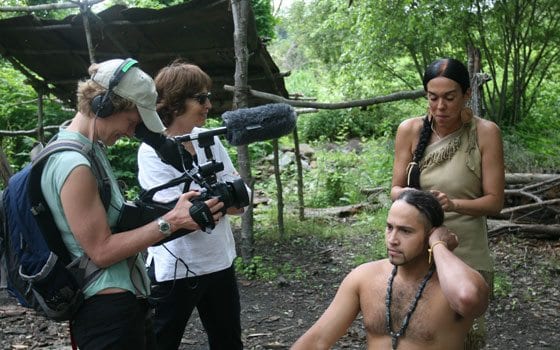

Author: Jill OrschellAllie Humenuk (l) and Anne Makepeace film a scene with Wampanoags at Plimoth Plantation’s Strawberry Thanksgiving.
There was a prophecy among the Wampanoag that their language would disappear, but if they wanted it, there would be a way to welcome the Wôpanâak language back.
A century after the last known fluent Wampanoag passed away, Jessie little doe Baird began to vividly dream that her elders were talking to her. At first she discounted the dreams, then one day as she drove down the highway and passed the exit sign for Sippewissett near Buzzard’s Bay, her dream clicked. The elders were asking her to reclaim the language.
The film, “We Still Live Here: Âs Nutayuneân” documents the series of serendipitous events that led Baird to a linguistic research grant at MIT and then through the challenges she faced resurrecting the language. The film screened last week at Independent Film Festival Boston to a packed audience of Wampanoag and Bostonians.
While working on the “We Shall Remain,” series for WBGH, director Ann Makepeace, met many of the Wampanoag people, including Baird. She said that she was, “completely blown away by the story of the resurrection of the language.”
After the Puritans landed at Plymouth Rock, which was part of the Wampanoag territory, they began to negotiate land treaties and establish a court system where these treaties were recognized. The Massachusetts Bay Colonies appointed “protectors” or overseers to native communities to supposedly protect native people’s interests. But what they created was an indentured servant system.
The overseer would ask native people to sign documents saying that they owed money, sometimes debts as small as 20 shillings, and then native people were given a choice: go to debtor’s jail or sell family members into labor to repay their debt. This practice was common all over the colonies and resulted in families being split up, children being raised outside of their culture and this practice became a contributing factor toward native communities, including Wampanoag, losing the foundation of their language.
The Wampanoag people quickly learned that they would need to create their own system of documentation to protect their people and their land. They taught themselves how to write Wôpanâak and create their own land deeds and paper trails.
“When Wampanoag people actually started to say, ‘Well, you know actually, I don’t make an X, this is how I write my name. I write in my language,’ it started to be a problem for the system,” said Baird. “In fact during the 1700s it’s estimated that two-thirds more Wampanoag people were literate in Wampanoag than in English.”
A combination of court documents kept by the Wampanoag in their native tongue with English translations and journals gave Baird a foundation for reclaiming the language. Working with linguists at MIT, Baird was able to create a Wampanoag dictionary and expand the lexicon using similar Algonquin languages. Her greatest achievement is teaching a handful of Wampanoag how to speak — Baird’s youngest daughter Mae Alice is the first native speaker in seven generations.
“Sometimes I help my mom,” said Mae Alice, “and I really like it.” She said that she taught her friends how to say “hello” in Wampanoag and Baird interjected that Mae Alice has also been teaching words to her school bus driver.
The Wôpanâak Language Reclamation Project has just secured enough funding to establish a full-time apprenticeship program, and they are hopeful that they can open a language school in 2015.
To learn more about the language reclamation project, visit wlrp.org and to find out where you can see “We Still Live Here: Âs Nutayuneân,” visit http://makepeaceproductions.com.






